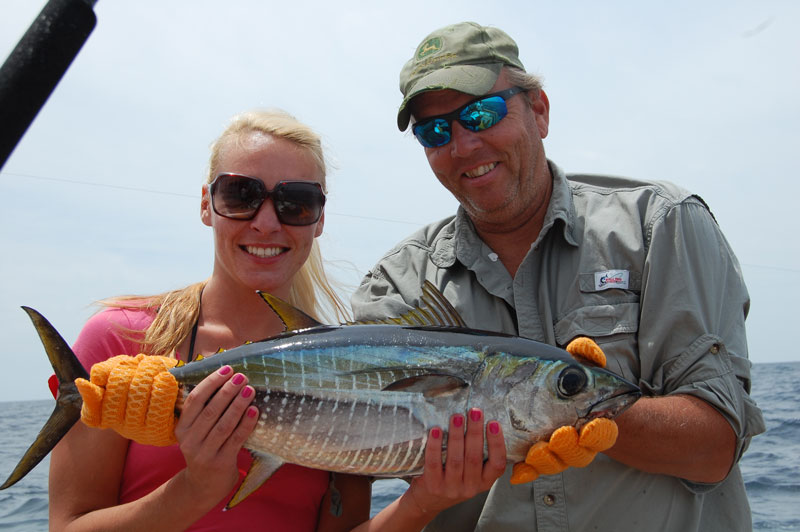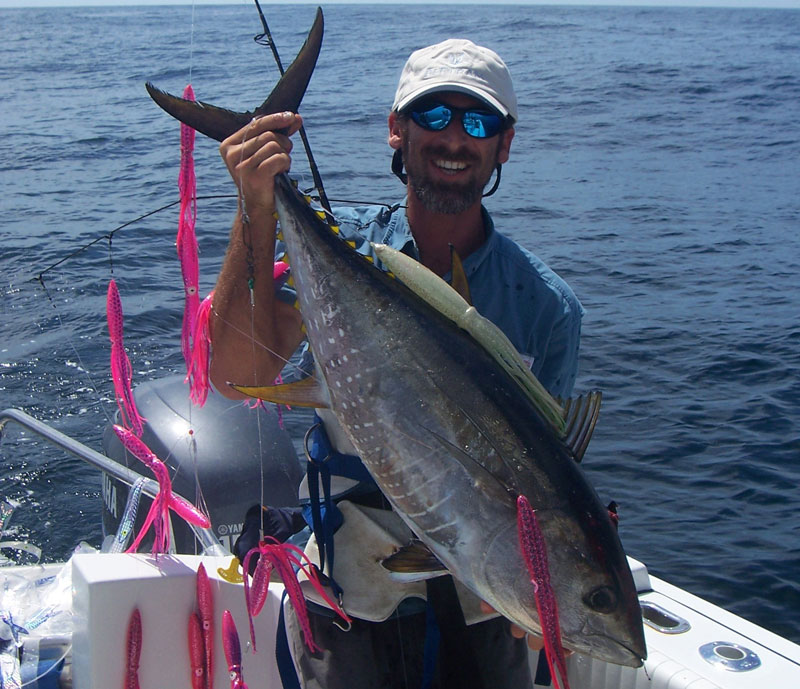Trolling, chunking, and jigging are popular methods for pursuing offshore gamefish, and all three tactics are effective – but not every day. The savvy tuna angler keeps options open when running offshore and prepares for whatever bite presents itself. Daily changing conditions require anglers to be ready for everything from old-school trolling to new-wave jigging. Learning to be a multidimensional tuna fisherman increases your chances of consistent success. This is part one of a three part series on catching yellowfin; we’ll cover chunking and trolling in the next couple editions of FishTalk. But typically the early season starts off by trolling, so here we go.

Trolling for Yellowfin Tuna
There are many theories on trolling spreads. Mine has always been the more lines in the water, the better. An 11-line starting spread gives a variety of offerings to find the preferred offering of the day, assuming your pit can handle that many rods. Of course, the more lines that are pulled, the greater the headaches and chance for tangles. Pulling a spread this big is a tradeoff. Only with experimentation can anglers decide how many lines can be trolled comfortably on their own boats. If you’re just beginning the adventure of offshore fishing, simplicity works. A basic five-line spread including two flat lines, two rigger lines, and a center shotgun is a good starting point. This is the foundation upon which the building blocks of tuna trolling are added.
The next step would be to add two long-rigger lines, then a dedicated deep planer line, then more wherever you can fit them. Artificial or rigged natural baits are both equal to the task of catching tuna. Spreader bars have been the hot ticket for the past 20 years. However, tuna are often hesitant to feed on surface trolled bait. On these days, anglers may find a black/purple Iland Lure skirted over a medium ballyhoo or 3 1/2 drone spoon trolled off a planer just the ticket for putting fish in the box.
Trolling Spreads
For a typical spread, set the flat lines at 25 and 35 feet. Run a center flat line 50 to 60 feet off the transom. This forms a triangle of bait close to the boat. Set the short rigger lines at 75 and 100 feet respectfully with long riggers 150 and 200 feet. The shotgun rig is run back 250 to 300. If a lot of boats are trolling the area tight on a bite, caution needs to be used as to how far back the shotgun is pulled so it’s not cut off by an unaware captain.
A large rigged ballyhoo or bird with triple green machines are a good choice for the shotgun position. Rigged ballyhoo (naked or skirted) along with the vast array of artificial lures like Green Machines can be pulled in any line position with success. Cedar Plugs work well for flat lines. Spreader bars work well off short riggers and in the center “sweet spot” position which is behind the short riggers in the middle of the spread (typically pulled from up on the bridge). Try to position spreader bars so the bar is actually out of the water and the squids are skipping around.
Two of the most popular charterboat baits are a blue/white Ilander skirted over medium ballyhoo, and the multi-colored spreader bar rigged with a green machine as the trailing bait. Color preference varies day to day, but, green, pink and blue/white are fairly consistent with yellowfin. On overcast days or early mornings try a black/purple skirt. Do not discount the fact that naked rigged baits sometimes out preform skirts and colors.

Tighten up or stretch out the spread when looking for the first bite of the day. Some days yellowfin feed near the transom, but other days not so much. Regardless of how many lines are trolled, it’s imperative to space lines in a manner that prevents entanglement on turns. Long lines need to swing in unison. This is accomplished by placing them as previously described or positioning them so they are able to swing over top shorter lines. As a rule of thumb, when setting lines remember: the longer the line, the higher should be pulled from the boat.
Trolling Speed
Changing conditions like wind, current, and the state of the ocean affect which speed will be best. Six to seven knots is a rule of thumb with naturals or when mixing naturals with artificial lures. Rigged bait should look like they’re swimming in the water, whether you’re pulling ballyhoo, mullet, mackerel, or squid. Bumping up to eight, nine, or even 10 knots in not out of the question for an artificial spread or if skipping naturals.
You’re not going to out-run tuna that want to eat, and if your lures and ballyhoo are swimming and not spinning, chances are the speed is acceptable. Of course, if the fish are not cooperating, changing boat speed can turn on a bite. Also try trolling with, against, and across the current until a bite preference is determined. Keep one eye on the sonar, too, and if fish are observed holding deep, try placing the boat into neutral for several seconds to allow the baits to sink. When applying this tactic baits are often attacked when the boat is put back in gear and they begin to rise back towards the surface. Be sure to troll across both sides of a temperature break, and try trolling both with and against the current on both sides.
Assessing the Conditions
An angler must be observant and read the signs of the ocean. Weed lines, temperature breaks, and generally paying attention to your surroundings helps to put fish in the boat. A look toward the sky reveals the world’s best fishermen – the bird’s survival depends upon it. When birds feed, pay attention. Gulls, terns, and pelican work inshore waters, while further offshore, storm petrels, jaegers, and shearwaters direct anglers to action. When you see several birds heading in the same direction, they just gave a new compass bearing to troll. Birds can see feeding action miles before anglers can on the horizon, thanks to their height advantage. Also, the bird’s acute hearing is not overshadowed by the drone of engines and they may tune in on squawking from great distances.

Even a flock of birds racked up on the surface is a floating giveaway. The surface feeding action has stopped when you find them sitting on the surface, however, it may still be continuing underneath. The birds, patiently waiting for another outbreak on the surface, are drifting with the current so try trolling against the current to find the fish. Deep bait often produces results at this time, and keep in mind, a hovering bird or birds are probably over deep baitfish. Do not give up on an area that birds are watching.
Raising Fish
You can use your boat and your spread to draw deep fish up to the surface. Pull a dredge – they are not just for billfish, and can attract tuna right to the transom. Daisy-chain type teasers are also popular with tuna. The more activity in your spread that creates simulating feeding or fleeing fish, the better. This is one reason spreader bars work so well.
How big a bar should you pull? Most anglers are restricted due to the size of their tackle. You have all 30s or smaller? No problem, here is an alternative: pull big spreader bars without thook-baits off your outriggers, in place of teasers. Then position a hook-bail like a Green Machine or ballyhoo three feet behind the spreader bar, from the short rigger position. This trolling technique works because of nature’s rule, survival of the fittest – tuna will usually attempt to pick off the weakest or trailing bait, and leave the spreader bar itself alone (although not always!).
Tuna are school feeders, so don’t be content when the first rod goes down. Maintain trolling speed to trigger additional strikes; some captains actually speed up to entice more hits after the first strike. At the very least, have the crew grab lines and jig them to put additional action into the bait after that first hookup. Circle towards the hooked tuna, while waiting on additional bites.
See Yellowfin Tuna Tactics Part II: Chunking for Yellowfin Tuna
and
Yellowfin Tuna Tactics Part III: Jigging for Tuna
- By John Unkart, author of “Offshore Pursuit” and “Saltwater Tales, available on Amazon.”